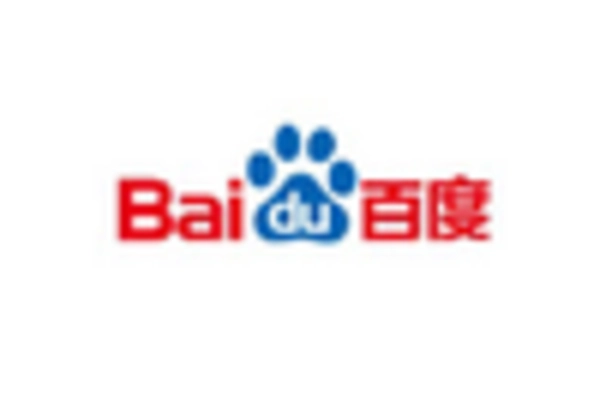The Voice Search Market is currently characterized by a dynamic competitive landscape, driven by rapid technological advancements and increasing consumer adoption of voice-activated devices. Major players such as Google (US), Amazon (US), and Apple (US) are at the forefront, each leveraging their unique strengths to capture market share. Google (US) continues to innovate with its Google Assistant, focusing on enhancing natural language processing capabilities, while Amazon (US) emphasizes integration with its vast ecosystem of smart home devices. Apple (US), on the other hand, is strategically positioning Siri to enhance user privacy and security, appealing to a growing consumer base concerned about data protection. Collectively, these strategies not only intensify competition but also foster an environment ripe for innovation and consumer engagement.
In terms of business tactics, companies are increasingly localizing their operations to better cater to regional markets, optimizing supply chains to enhance efficiency. The Voice Search Market appears moderately fragmented, with a mix of established giants and emerging players. The collective influence of key players shapes market dynamics, as they engage in strategic partnerships and collaborations to bolster their technological capabilities and expand their reach.
In August 2025, Google (US) announced a partnership with a leading automotive manufacturer to integrate its voice search technology into new vehicle models. This strategic move is significant as it not only expands Google’s presence in the automotive sector but also enhances the functionality of voice search in everyday life, potentially increasing user engagement and satisfaction. Such integrations may redefine how consumers interact with technology, making voice search an integral part of their daily routines.
In September 2025, Amazon (US) unveiled a new feature for Alexa that allows users to control smart appliances through voice commands more intuitively. This development underscores Amazon's commitment to enhancing user experience and solidifying its position in the smart home market. By continuously improving the functionality of its voice assistant, Amazon is likely to maintain a competitive edge, appealing to tech-savvy consumers who prioritize convenience and efficiency.
In July 2025, Apple (US) launched an updated version of Siri, incorporating advanced machine learning algorithms to improve contextual understanding. This enhancement is crucial as it positions Apple to compete more effectively against rivals, particularly in the realm of personalized user experiences. By focusing on machine learning, Apple may not only enhance Siri's capabilities but also align with broader trends in AI integration, which is becoming increasingly vital in the Voice Search Market.
As of October 2025, current competitive trends indicate a strong emphasis on digitalization, sustainability, and AI integration. Strategic alliances are becoming pivotal, as companies recognize the need to collaborate to enhance technological capabilities and market reach. Looking ahead, competitive differentiation is likely to evolve, shifting from traditional price-based competition to a focus on innovation, technological advancements, and supply chain reliability. This transition may redefine the competitive landscape, compelling companies to invest in cutting-edge solutions that resonate with consumer expectations.

















Leave a Comment